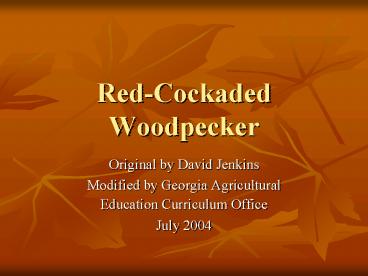RedCockaded Woodpecker - PowerPoint PPT Presentation
1 / 31
Title:
RedCockaded Woodpecker
Description:
The red cockaded woodpecker is an endangered bird that thrives in old growth ... This makes it accessible to Owls, Squirrels, Wood ducks, and Raccoons. Conclusion ... – PowerPoint PPT presentation
Number of Views:781
Avg rating:3.0/5.0
Title: RedCockaded Woodpecker
1
Red-Cockaded Woodpecker
- Original by David Jenkins
- Modified by Georgia Agricultural Education
Curriculum Office - July 2004
2
Red-Cockaded WoodpeckerPicoides borealis
3
Introduction
- Red Cockaded Woodpecker
- The red cockaded woodpecker is an endangered bird
that thrives in old growth pine stands in the
southeastern united states. - It entered the endangered species list in 1970.
4
Introduction
- It has become endangered primarily due to habitat
loss. - Historically its range extended from Florida to
New Jersey and as far west as Texas and Oklahoma.
5
Habitat
- The red-cockaded woodpecker makes its home in
mature southern pine forest, preferably longleaf
pines (Pinus palustris).
6
Habitat
- They have a fairly open under story free of
hardwoods. - Historically this was controlled by wildfires set
by Indians. - Now land owners use prescribed fires.
7
Habitat
- The trees must be living.
- The average age of the trees are 80 to 150 years
old.
8
Habitat
- The tree must also have a fungus called Red Heart
Disease. - This causes the heartwood to become soft.
- Cavities take 1 to 3 years to excavate.
9
Habitat Destruction
- From the late 1800s to the mid 1900s mature
pine forest began to disappear due to logging.
10
Habitat Restoration
- Most of the forestlands that are large enough to
provide habitat are on federal lands. - The U.S. Forest Service and Department of Defense
have developed special management guidelines for
woodpecker habitat.
11
Habitat Restoration
- Industry has also made conservation agreements by
setting aside woodpecker habitat. - Small landowners are also helping out by setting
aside land and using proper management
techniques.
12
Habitat Restoration
- Many management plans include cavity management.
- This includes removal of squirrels or other
birds. - This increases habitat for the Red Cockaded
Woodpecker.
13
Habitat Restoration
- Some management plans include artificial
cavities. - Beginning of the cavity.
14
Habitat Restoration
- Clean Cavity
- Fitting of the cover
15
Habitat Restoration
- Using epoxy
- Making it blend
- Painting stripes to give the effect of sap.
16
Description
- White post ocular spot.
- Bold white cheeks.
- White under parts.
- Black rump.
17
Description
- Black tail has white outer tail feathers barred
with black. - Adult male has a red spot at rear margin of white
face and is rarely visible.
18
Description
- Approximately 7 inches long.
- Wingspan about 15 inches
- Its back is barred with black and white
horizontal stripes. - Black cap and nape
19
Nesting
- Red-Cockaded Woodpeckers nest in clusters.
- They have 1 to 20 or more cavity trees on 3 to 60
acres. (Avg. 10 acres) - An active cavity has resin well that exude sap.
This is a protective barrier from snakes, rats,
and other possible predators.
20
Nesting
- A typical territory for a group ranges from about
125 to 200 acres, but can be as low as 60 acres. - The size of the territory is related to habitat
stability and population density.
21
Reproduction
- Red Cockaded Woodpeckers are territorial
cooperative breeders. - They keep the same mate for several years and
sometimes for their lifespan.
22
Reproduction
- Nesting season lasts from April through June.
- Three to four eggs are laid.
- Group members help incubate the eggs for 10 to 12
days.
23
Reproduction
- Once hatched, the nestlings stay in the cavity
for about 26 days. - The young often remain with the parent forming
groups of three to four. - Only one pair breeds within a group.
24
Population Levels
- It is estimated that there are 4,500 family units
or groups of Red-Cockaded Woodpeckers. - It is estimated that there are 10,000 to 14,000
individuals in existence.
25
Population Levels at the Jones Center
26
Range
- The Red-Cockaded Woodpeckers range.
- Historically, they extended from Florida to New
Jersey, as far west as Texas and Oklahoma and as
far inland as Missouri, Kentucky, and Tennessee. - Now they Range from Florida to Virginia and west
to Oklahoma and east Texas which is about 1 of
the original range.
27
Diet
- Primary
- Beetles, Spiders, Roaches, Grasshoppers,
Caterpillars, Wood-boring Insects - Lesser Quantities
- Seeds, Fruits
28
Primary Predator
- Rat Snake
- They climb the tree and eat the eggs or
nestlings. - The woodpecker protects itself by chipping small
holes in the tree causing the sap to ooze out. - This inhibits the movement of the snakes scales,
preventing it from climbing higher.
29
The Red Cockaded Woodpeckers Role
- Abandoned cavities are used by smaller birds such
as Chickadees, Blue birds, or other Woodpeckers. - Sometimes larger wood peckers such as Pileated
take over the cavity enlarging it. This makes it
accessible to Owls, Squirrels, Wood ducks, and
Raccoons.
30
Conclusion
- The Red-Cockaded Woodpecker is a vital organism
in its habitat. Federally funded programs should
remain in place to maintain, if not increase
population numbers. This is a very unique bird
and should be preserved for future generations.
31
References
- http//rcwrecovery.fws.gov/rcw.html
- http//texas-extension.tamu.edu
- http//www.geocities.com/Heartland/5960/recockade.
html - http//birding.abrut.com/library/weekly/aa01230a.h
tm - http//www.jonesctr.org/conservation/monitoring_ma
pping/rcw_restoration_onichauway.htm

